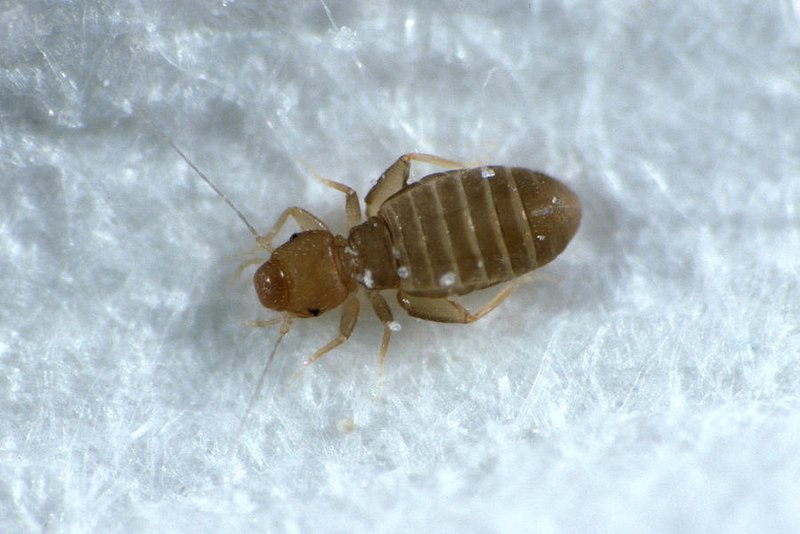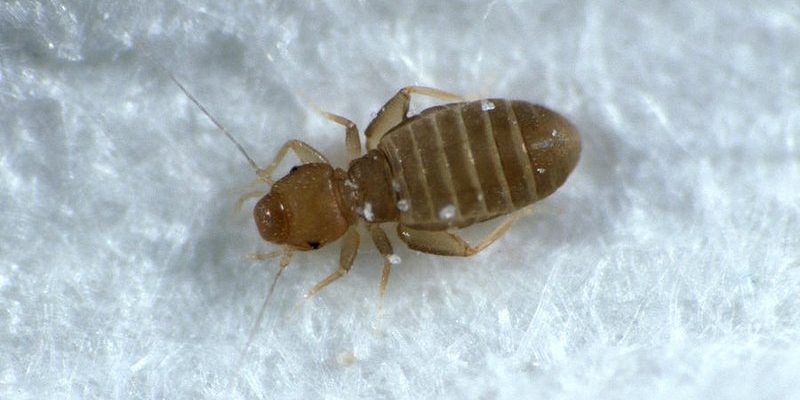
You might have stumbled upon a booklouse while browsing through old books or papers, and wondered what these tiny creatures are. Booklice, which belong to the order Psocoptera, are not actually lice. They are small, wingless insects that thrive in damp environments. Their name derives from their fondness for feeding on mold and mildew, often found in the pages of damp books or stored papers.
These minuscule pests, typically measuring between 1 to 2 millimeters in length, can range in color from pale yellow to dark brown. While they often go unnoticed due to their size, they can be quite a nuisance if they invade your living space. Though they don’t bite or sting humans, their presence can signal underlying moisture issues, which might lead to more significant problems.
Beyond their physical features, booklice play a role in the ecosystem. They help break down organic matter, contributing to the recycling process in nature. So, while you might not welcome them into your home, these tiny insects have their place in the larger story of life on Earth.
Physical Characteristics of Booklice
Booklice are fascinating little creatures. You’ve probably seen bugs that look quite similar, but here’s what distinguishes them. Their bodies are oval-shaped, and they lack wings, which makes them quite different from other insects that might buzz around your home. Instead, they have a soft, delicate exoskeleton that requires a moist environment to survive.
When you look closely, you’ll notice that their antennae are long and slender, which helps them navigate their surroundings. Unlike many insects that scurry away when disturbed, booklice tend to freeze in place, which can make them easy to observe if you pay attention. Their movement is often slow and deliberate, which adds to their unassuming nature.
Another interesting feature is their life cycle. A female booklouse can produce dozens of eggs during her lifespan. These eggs hatch into nymphs, which resemble miniature adults but lack fully developed wings. This means that, in optimal conditions, infestations can grow quickly. Add some warmth and humidity to the mix, and you have a recipe for rapid reproduction.
Habitat and Distribution
Booklice prefer moist environments, making them common in homes with high humidity. You might find them in kitchens, bathrooms, or even in the basement. They can often be found in piles of books, cardboard boxes, or on food products that have been exposed to moisture. This preference for damp areas is also why they tend to congregate in areas where mold may be present.
While many people associate booklice with books and paper, they can actually thrive in a variety of environments. Many species are found in leaf litter, decaying wood, and even under the bark of trees. Outside, you’ll often find them in gardens where they feed on algae, fungi, and decaying plant material, contributing to nutrient cycling in the soil.
Geographically, booklice are widespread and can be found in nearly every part of the world. They are especially prevalent in warm and humid climates, but can also survive in cooler regions if conditions are right. Their adaptability makes them resilient little creatures in the grand tapestry of life.
Diet of Booklice
It’s interesting to note that booklice are primarily detritivores, feeding on dead or decaying organic matter. This includes mold, fungi, and even the fibers of paper and cardboard. If you have old books in your home that have been exposed to moisture, booklice might find them an appealing meal. However, their diet doesn’t solely consist of materials around your home.
You might be surprised to learn that booklice also feed on small quantities of plant material. In outdoor settings, they might digest algae or lichen, which adds to their role in the ecosystem. This means that while they’re often viewed as pests, they also perform a vital function by helping decompose organic matter.
It’s also worth noting that booklice require moisture to survive. In dry environments, they struggle to find food sources and can quickly perish. For this reason, keeping your home dry and well-ventilated is essential in preventing infestations, as it impacts their food availability and survival rate.
Booklice and Their Impact on Humans
While booklice don’t pose any direct threat to humans by biting or transmitting diseases, their presence can indicate underlying issues. A booklouse infestation often points to excess moisture or mold, which can have health implications for people, especially those with allergies or respiratory problems. Mold can exacerbate these conditions, so finding and addressing moisture problems is crucial.
For book lovers, discovering these pests in your collection is an unwelcome surprise. They may not damage the content directly, but their feeding can lead to staining and deterioration of the pages over time. This makes it important to handle infested books carefully and take steps to protect your library.
On the bright side, their presence can alert you to potential issues in your home. Identifying a booklouse infestation can lead to necessary home improvements, such as enhancing ventilation or addressing leaks, which ultimately helps protect not just your books but your home environment as well.
How to Control Booklice
If you find yourself dealing with a booklice problem, don’t panic! There are effective ways to manage their population. The first step is to identify and eliminate the source of moisture. This could entail fixing leaks, using dehumidifiers, or ensuring proper ventilation in areas prone to humidity. By tackling the root cause, you greatly reduce the chances of a re-infestation.
Next, cleaning your living space is key. Vacuuming regularly helps remove food sources and potential hiding spots. Pay special attention to areas where you store books or paper products. If you notice any infested items, consider placing them in a sealed bag and leaving them in the freezer for a few days to kill any booklice or eggs present.
In some cases, using a mild insecticide may be necessary to manage larger populations. However, it’s essential to choose products that are safe for indoor use, especially around children and pets. Always read the instructions carefully and think about consulting a pest control professional if the problem persists.
Interesting Facts About Booklice
| Size: | 1 to 2 millimeters |
| Color: | Pale yellow to dark brown |
| Habitat: | Moist environments, books, and paper products |
| Diet: | Decaying organic matter, mold, fungi |
| Lifespan: | Several weeks to a few months |
Booklice vs. Other Pests
It’s common to confuse booklice with other small insects, especially those that also love to hang around our homes. One primary rival is the dust mite, which often thrives in similar conditions. However, unlike booklice, dust mites feed on human skin flakes, making them a common allergy trigger.
Another similar pest is the furniture beetle, which may also inhabit books. While furniture beetles can cause more significant damage to wood and paper products, they are larger and tend to leave noticeable damage behind as they burrow into materials.
Understanding these differences can help in identifying the right treatment method. If you’re unsure, observing the insects’ behaviors and environments can lead you to a more accurate identification and effective control strategies.
FAQ
Can booklice harm my books?
While booklice don’t directly damage books, they can feed on mold and the fibers in paper, potentially leading to staining and deterioration over time. If you notice them in your collection, it’s essential to address any underlying moisture issues to protect your books.
Are booklice dangerous to humans?
Booklice are not dangerous to humans as they don’t bite or transmit diseases. However, their presence can indicate moisture problems that may contribute to mold, which can be detrimental to health, especially for those with allergies or respiratory conditions.
How can I prevent a booklice infestation?
The best prevention method is to reduce humidity in your home. Use dehumidifiers in damp areas, fix leaks, and ensure good ventilation. Regularly clean areas where books are stored and keep them in a dry environment to discourage infestations.
What should I do if I find booklice in my home?
If you find booklice, start by addressing any moisture issues immediately. Clean the affected areas, and consider placing infested books in sealed bags for treatment. If necessary, consult a pest control professional for help with persistent infestations.
Do booklice have natural predators?
Yes, booklice do have natural predators, including certain types of spiders and predatory mites that may help keep their numbers in check. However, in indoor environments, these predators may not be present, making it essential to manage populations through other means.
Can booklice survive in dry conditions?
Booklice struggle in dry conditions since they require moisture to thrive. If the humidity levels drop significantly, they may die off or move to more favorable environments. Maintaining low humidity is key to preventing infestations.
How long do booklice live?
The lifespan of a booklouse typically ranges from several weeks to a few months, depending on environmental conditions such as humidity and food availability. In ideal conditions, they can reproduce quickly, leading to larger populations.
Are there different species of booklice?
Yes, there are several species of booklice, each with their preferences for habitat and diet. Some live primarily in homes, while others are more commonly found in outdoor environments, feeding on plant material or decaying organic matter.
Can booklice reproduce quickly?
Yes, booklice can reproduce rapidly, with females laying dozens of eggs in their lifetime. If conditions are favorable, their populations can grow quickly, making it important to address moisture problems as soon as they’re detected.
Is it necessary to treat for booklice if I only see a few?
While a few booklice might not seem alarming, their presence can indicate moisture issues that may lead to larger infestations. It’s wise to address any signs early on, reducing the risk of a more significant problem down the line.
What products are safe to use against booklice?
When dealing with booklice, it’s essential to choose products that are safe for indoor use, particularly around children and pets. Look for mild insecticides or natural remedies like diatomaceous earth, which can effectively control populations without harsh chemicals.

